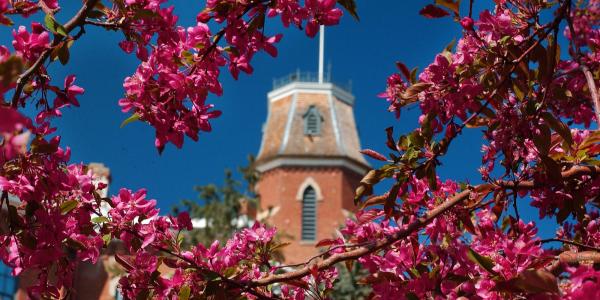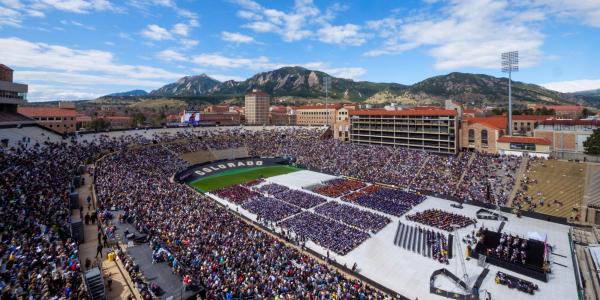The city of Boulder and CU Boulder today jointly released for public review a draft annexation agreement for CU Boulder South that is the culmination of years of collaboration between the city, county, university and community to achieve vital flood protection for thousands of downstream Boulder residents.
The CU Boulder South annexation agreement is a legal document that explicitly sets the requirements and conditions for the annexation of 308 acres of CU Boulder land at the junction of U.S. 36 and Table Mesa Drive into the city. Terms include the university’s commitment to the transfer of 155 acres to the city for flood protection and dedication of open space uses, the transfer of water rights to the city needed for habitat restoration, development phasing that prioritizes housing, and continued public access to the site. It also contains numerous binding covenants that set limits on building sizes, heights and locations, as well as an actively managed multi-modal traffic plan.
CU Boulder and the city have long agreed on the provision of housing for faculty, staff and non-freshman students as the predominant use of the site, helping to make a meaningful impact on the severe housing shortage in the Boulder community. Along with housing for CU affiliates, the draft agreement includes the dedication of five acres of the site for development of permanently affordable housing available to all who qualify in the Boulder community, not just university affiliates.
“I am thrilled that we are now on the cusp of moving forward with one of the most important city-university projects for our community in at least a generation,” CU Boulder Chancellor Philip DiStefano said. “We’ve engaged in years of collaboration, realizing that the end result for CU Boulder South does not have to be an either-or proposition.
“Comprehensively, we can achieve vital flood protection for the community, increase access to much-needed workforce and student housing, preserve open space and valuable habitat, protect pristine views and sightlines, maintain legal building height limits, lead on climate action and transportation solutions, and continue recreational use for the public.”
The July 12 release of the draft annexation agreement precedes a number of avenues for community engagement and feedback leading up to City Council’s consideration of the agreement later this summer. These opportunities and other key dates include:
- July 14, 4 p.m.: The city will host a community listening session.
- July 15, 4 p.m.: CU Boulder will host a virtual briefing for the campus and broader community.
- July 14, to Aug. 13: The city will conduct a BeHeardBoulder questionnaire through which community members and university affiliates can share feedback on the draft agreement.
- July 22: Boulder Planning Board will host a public hearing and make a recommendation to City Council.
- Aug. 3: City Council will hold a first reading.
- Sept. 7: City Council will hold a second reading and public hearing.
- Sept. 21: City Council third reading.
In addition to City Council making a final decision in September 2021, the annexation agreement also requires University of Colorado Board of Regents approval.
CU Boulder South is a 308-acre plot of land purchased by the university in 1996 to ensure the university’s long-term future and to provide Colorado citizens with access to quality education for generations to come.
The draft annexation agreement codifies numerous values shared by the university and community, providing explicit and legally binding assurance to the community regarding what the university can and cannot develop.
Key among the alignment reached to date and outlined in the draft annexation agreement:
- The university’s commitment to the transfer of 155 acres to the city for flood protection and open space. This includes the original commitment of 80 acres for flood mitigation and open space, plus an option for the city to acquire an additional 75 acres for open space.
- The construction of flood protection for 2,300 downstream Boulder residents and 1,100 homes.
- The preservation of 119 acres overall for permanent open space, and the transfer of the needed water rights for habitat rehabilitation and maintenance.
- A limit on future development to 129 acres of the 308-acre parcel, with no development allowed within the 500-year floodplain.
- Restrictions on density and intensity of future development.
- A required minimum 2-to-1 square footage ratio of housing to non-housing buildings.
- A 750,000-square-foot cap on the amount of non-housing development allowed.
- A ban on any non-residential development prior to at least 150 units of housing being built.
- The dedication of five acres for development of permanently affordable housing available to all who qualify, not just university affiliates.
- Preservation and protection of valuable wetlands and natural habitat, including lands near the sensitive state habitat area.
- The installation of performance-based transportation plans and trip caps to limit future traffic.
- The creation of a multimodal hub with connections to the larger transportation network.
- The dedication of two acres of land for a public safety facility.
- The provision of continued shared recreation uses for the community and university, including parks, trails and fields.
Once annexation is complete, the university will embark on a master planning effort around its future site plans before any development begins. CU Boulder development at the site would not occur until after the city’s flood protection project is built. The city will maintain review and comment periods for those site plans, as well as each phase of future development at CU Boulder South to ensure compliance with the final binding annexation agreement.



